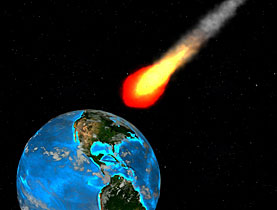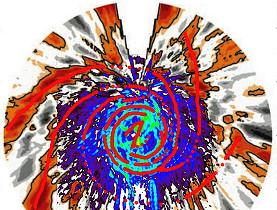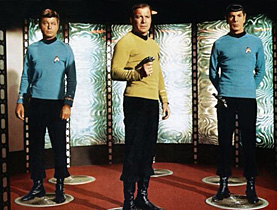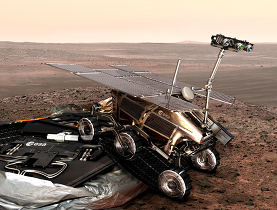Science squares up to asteroid threat

War, collapsing banks and melting polar ice caps aside, humans should count their blessings – at least the planet hasn't been wiped out by a giant asteroid. Yet.
The issue of errant space rocks has become a disquieting one for some of the world’s top scientists, who in December asked the United Nations for $100 million (SFr112 million) per year to establish detection mechanisms and more for vessels to fend off the danger from space.
Astronomers say cataclysmic impacts, such as that which is believed to have wiped out the dinosaurs, occur every 60 million to 100 million years – and that Earth is overdue.
A private organisation called the International Panel on Asteroid Threat Mitigation, led by former United States astronaut Russell Schweikart, has calculated the probability of an asteroid larger than 45 metres in diameter striking the earth to be two or three times per 1,000 years.
“We know that Earth has been hit by large objects in the past and it will be hit in the future,” said Ingo Leya, a meteorite expert at Bern University’s space research and planetary sciences department. “The last time was 75 million years ago, so it’s time.”
The call for cash comes as both amateur and professional astronomers turn their eyes to the sky: the Swiss launch of the International Year of Astronomy is scheduled for the beginning of February.
But Leya says chances are actually quite slim that there will be a major disaster within our lifetime.
“Fortunately, the bombarding decreased at the beginning of the solar system exponentially,” he said.
Massive blowback
“At the moment we know that there are up to 200,000 objects floating around with diameters of up to a few hundred kilometres,” Leya told swissinfo. “And usually they stay in their orbits, but the orbits are not stable.”
In 2004 an asteroid called Apophis travelled at a trajectory that led scientists to believe there was as high as a 2.7 per cent chance of it colliding with the Earth in 2029.
Those projections were eventually reduced to a one in 45,000 chance and experts say that even if the 390-metre wide rock struck the Earth, it would kill around ten million people in Central America or trigger a massive tsunami but would not wipe out life on Earth.
An asteroid with a diameter of between ten and 40 kilometres, depending on its composition, would produce a massive blowback of atmospheric pressure as it hurtled toward Earth and explode some 20 kilometres above the surface, creating a cloud of dust that would leave the planet without sunlight for four to five years.
The Earth would suffocate, it would get cold and life would end.
Most experts agree it is better to divert an asteroid than destroy it. Ideally, authorities would attach a solar sail or a super-efficient plasma engine to an asteroid somewhere in deep space. By nudging an asteroid by the smallest of margins, scientists could rule out the possibility of a collision.
“For me, this is very, very exotic,” said Axel Deich, the chief executive of Zurich-based Oerlikon Space, a major supplier to the European Space Agency (Esa).
“Solar sails have been developed,” he added. “In principle, it’s available but I think just to imagine that this type of technology could be fixed to an asteroid, would be very complicated.”
Technology shortfall
Apart from the complexities linked to fixing a sail to a rotating asteroid would be the task of actually getting it into space. Today’s generation of spacecraft lacks the capacity to transport anything close to a one-square-kilometre foil into deep space.
“At the moment, we have no proper rocket to bring a lot of material outside the earth’s gravitational field. And you need a lot,” Leya said.
“The most important issue is timing,” according to Deich. “You must know if you have ten years, 15 years or just ten months.”
With ten to 15 years to play with, engineers might be able to develop vehicles capable of carrying these types loads into outer space. But it takes years to launch a mission, even if most components are already developed, Deich says.
“For a typical mission, you have to qualify the technology, and I would recommend to test it. It takes between six and ten years,” he said. Even when Esa developed its Ariane 5 launch vehicle, it borrowed the most critical part, the engine, from the Ariane 4. Developing the new launcher nevertheless took four years.
“The only technology that is available on the spot is ballistic missiles,” Deich told swissinfo.
“I think if [the asteroid] is very close to our planet, then nothing else than nuclear… could be envisaged.”
swissinfo, Justin Häne
As Earth faced obliteration by an asteroid in the 1998 film Armageddon, authorities dispatched an oil rig worker to land on it and insert a nuclear weapon. In the end, the hero perished in a nuclear blast but the asteroid was destroyed and the world saved.
Ingo Leya of Bern University says that strategy would be “far out of reach” of today’s technology. He agrees that sending up a ballistic missile with a nuclear would be more realistic. “Better having some smaller pieces hitting the earth than one big one.”
The most effective approach would be what amounts to a game of cosmic billiards, says Axel Deich of Oerlikon. A rocket carrying a large ballast would travel into space, slam into an asteroid and divert its course.
Most asteroids float in a belt between Jupiter and Mars. As the objects bump into each other and because of their interaction with Jupiter, orbits can become elliptical and cross Earth. Solar winds also play a factor, kicking asteroids out of their regular orbits.
Models used by scientists consider the gravitational field for all the planets in the solar system and help with projections for 10-20 years.
The mass of the asteroid belt is around 4% of the mass of the moon, and much of that is made up by a few large rocks.
Roughly 40,000 tons of meteorite material hit the Earth each year. Most of that is dust.
The International Year of Astronomy is organised by the International Astronomical Union and Unesco, the cultural body of the United Nations. It will highlight the 400th anniversary of Galileo’s first use of an astronomical telescope.
The organisers hope to increase awareness, empower astronomical communities in developing countries, develop science education, strengthen ties among scientists and improve the gender balance.
Switzerland’s national opening ceremony is on February 5.

In compliance with the JTI standards
More: SWI swissinfo.ch certified by the Journalism Trust Initiative



You can find an overview of ongoing debates with our journalists here. Please join us!
If you want to start a conversation about a topic raised in this article or want to report factual errors, email us at english@swissinfo.ch.